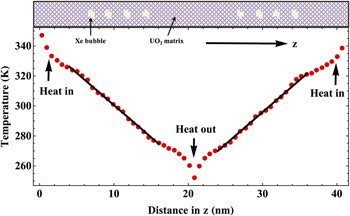Crossref Citations
This article has been cited by the following publications. This list is generated based on data provided by
Crossref.
Chen, Weiming
and
Bai, Xian-Ming
2020.
Unified Effect of Dispersed Xe on the Thermal Conductivity of UO2 Predicted by Three Interatomic Potentials.
JOM,
Vol. 72,
Issue. 4,
p.
1710.
Zhu, Xueyan
Gong, Hengfeng
Zhao, Ya-Fan
Lin, De-Ye
Han, Guomin
Liu, Tong
and
Song, Haifeng
2020.
Effect of Xe bubbles on the thermal conductivity of UO2: Mechanisms and model establishment.
Journal of Nuclear Materials,
Vol. 533,
Issue. ,
p.
152080.
Guo, Xiang
Liu, Yang
Weng, George J.
Zhu, Linli
Lu, Jian
and
Chen, Gang
2020.
Microstructure‐Property Relations in the Tensile Behavior of Bimodal Nanostructured Metals.
Advanced Engineering Materials,
Vol. 22,
Issue. 6,
Wang, Yuanyuan
and
Zhao, Jijun
2021.
Numerical simulations of thermal conductivity in void-containing tungsten: Topological feature of voids.
Journal of Nuclear Materials,
Vol. 543,
Issue. ,
p.
152601.
Yoon, Bohyun
and
Chang, Kunok
2022.
Effective thermal conductivity model of porous polycrystalline UO2: A computational approach.
Nuclear Engineering and Technology,
Vol. 54,
Issue. 5,
p.
1541.
Hurley, David H.
El-Azab, Anter
Bryan, Matthew S.
Cooper, Michael W. D.
Dennett, Cody A.
Gofryk, Krzysztof
He, Lingfeng
Khafizov, Marat
Lander, Gerard H.
Manley, Michael E.
Mann, J. Matthew
Marianetti, Chris A.
Rickert, Karl
Selim, Farida A.
Tonks, Michael R.
and
Wharry, Janelle P.
2022.
Thermal Energy Transport in Oxide Nuclear Fuel.
Chemical Reviews,
Vol. 122,
Issue. 3,
p.
3711.
Jin, Miaomiao
Dennett, Cody A.
Hurley, David H.
and
Khafizov, Marat
2022.
Impact of small defects and dislocation loops on phonon scattering and thermal transport in ThO2.
Journal of Nuclear Materials,
Vol. 566,
Issue. ,
p.
153758.
Yang, Xiaolong
Tiwari, Janak
and
Feng, Tianli
2022.
Reduced anharmonic phonon scattering cross-section slows the decrease of thermal conductivity with temperature.
Materials Today Physics,
Vol. 24,
Issue. ,
p.
100689.
Wang, Ziqiang
Yu, Miaosen
Yang, Chen
Long, Xuehao
Gao, Ning
Yao, Zhongwen
Dong, Limin
and
Wang, Xuelin
2022.
Effect of Radiation Defects on Thermo–Mechanical Properties of UO2 Investigated by Molecular Dynamics Method.
Metals,
Vol. 12,
Issue. 5,
p.
761.
Cai, Mengke
Cong, Tenglong
Tian, Hongkang
and
Gu, Hanyang
2023.
Porosity effect on the thermal and mechanical properties of U-50Zr alloy: A molecular dynamics study.
Journal of Nuclear Materials,
Vol. 584,
Issue. ,
p.
154578.
Wang, Yuhui
and
Fu, Baoqin
2023.
Effect of hydrostatic strain on the thermal conductivity of β-SiC: A combined molecular dynamics and lattice dynamics investigation.
Journal of Materials Research,
Vol. 38,
Issue. 6,
p.
1634.
Kowsar, Z.
Zolfaghari, A.
Zamzamian, M.
Minuchehr, M.
and
Zangian, M.
2023.
Performance evaluation of thermal conductivity models for fission gases with application to UO2-zirconium dispersion fuel.
Annals of Nuclear Energy,
Vol. 186,
Issue. ,
p.
109721.
Li, Jade J.
Zagni, Nicola
Neilson, William D.
Gray, Rebecca L.
and
Murphy, Samuel T.
2023.
The incorporation of xenon at point defects and bubbles in uranium mononitride.
Journal of Nuclear Materials,
Vol. 586,
Issue. ,
p.
154656.
Liang, Chuanxin
Su, Yunting
Hao, Mengyuan
Dong, Tianjiao
Gong, Hengfeng
Liu, Wenbo
and
Wang, Dong
2023.
Microstructural evolution of gas bubbles and thermal conductivity in UO2-BeO bicrystal.
Journal of Materials Science,
Vol. 58,
Issue. 29,
p.
11944.
Wang, Ziqiang
Yang, Chen
Yu, Miaosen
Ma, Wenxue
Guo, Liyao
Wei, Zhixian
Gao, Ning
Yao, Zhongwen
and
Wang, Xuelin
2024.
Effect of fission products on the thermal conductivity of ThO2-A molecular dynamics study.
Nuclear Materials and Energy,
Vol. 39,
Issue. ,
p.
101681.
Bawane, Kaustubh
Kamboj, Anshul
Jin, Miaomiao
Minaruzzaman, Md
Alshannaq, Mutaz
Rickert, Karl
Mann, J. Matthew
Teng, Fei
Childs, Mason
Shao, Lin
Hurley, David H.
Zhang, Yongfeng
Khafizov, Marat
and
Kombaiah, Boopathy
2024.
In-Situ TEM study of microstructural evolution in proton irradiated single crystal UO2 under high-temperature annealing.
Acta Materialia,
Vol. 281,
Issue. ,
p.
120440.
Wang, Ziqiang
Yang, Chen
Yu, Miaosen
Ma, Wenxue
Guo, Liyao
Wei, Zhixian
Gao, Ning
Yao, Zhongwen
and
Wang, Xuelin
2024.
Dependence of thermal conductivity on radiation defects in ThO2 investigated by molecular dynamics method.
Nuclear Materials and Energy,
Vol. 39,
Issue. ,
p.
101673.
Bawane, Kaustubh
Kamboj, Anshul
Jin, Miaomiao
Minaruzzaman, Md
Alshannaq, Mutaz
Rickert, Karl
Mann, J. Matthew
Teng, Fei
Childs, Mason
Shao, Lin
Hurley, David H.
Zhang, Yongfeng
Khafizov, Marat
and
Kombaiah, Boopathy
2024.
In-Situ TEM Study of Microstructural Evolution in Proton Irradiated Single Crystal UO
<sub>2</sub> under High-temperature Annealing.
SSRN Electronic Journal,
Ferrigno, Joshua
Pavlov, Tsvetoslav
Poudel, Narayan
Salvato, Daniele
Tsai, Chuting
Merritt, Brian
Hansen, Alex
Munro, Troy
Cappia, Fabiola
and
Khafizov, Marat
2024.
Analysis of radially resolved thermal conductivity in high burnup mixed oxide fuel and comparison to thermal conductivity correlations implemented in fuel performance codes.
Journal of Nuclear Materials,
Vol. 596,
Issue. ,
p.
155090.
Yang, Jinlei
Li, Jianjian
Yan, Chao
Wang, Peng
Yang, Haobo
Qian, Xin
Yang, Kun
Xu, Shizhuan
and
Lin, Jun
2025.
Microstructure, thermal properties and irradiation behaviors of uranium nitride (UN) nuclear fuel densified by Spark Plasma Sintering (SPS).
Journal of Nuclear Materials,
Vol. 608,
Issue. ,
p.
155709.
